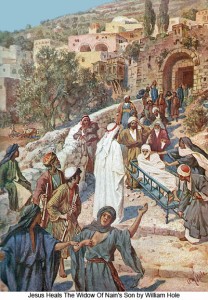Discovering biographical data about writers of Scripture is tough–so many centuries ago, questionable sources, different ideas about using others’ more famous names, etc. We probably know as much about Luke, however, the evangelist/writer/historian, as any author. In addition to his Greek nationality and professional background as a physician, Luke uses the ‘we’ pronoun in parts of Acts to indicate he was a traveling companion to Paul, and thus an eyewitness to the apostle’s astonishing ministry among the Gentiles.
Luke was also committed to putting the Gospel story and that of the early Church in historical context, vital for Christians and others to realize the birth, life, death and resurrection of Jesus Christ really happened during the reign of known historical Jewish and Roman figures.
But what we don’t know is if a widow raised Luke.
That might seem like an odd query, but even a cursory reading of Luke’s Gospel shows he had a special place in his heart for women who had lost husbands. Because a widow raised my brother and me, I noticed this early on but was still surprised to see the extent of his references to widows. While John never refers to this social class, and Matthew mentions widows only once and Mark three times, Luke cites widows twelve times– nine in the Gospel and three more in Acts.
That’s what led me to think perhaps he had a special sensitivity to the challenges they faced. While that is speculation, we do know that one of Luke’s underlying themes throughout both his volumes is the universal and inclusive love that the Gospel message carries to the downtrodden and outcast. This includes not just the poor and infirmed, but women, and particularly widows who have lost their husband’s economic and social support.
For example, Luke’s sensitivity to Mary’s unusual pregnancy is unique in the Gospel accounts, with texts of hymns (see Luke 1:46-56), prayers and innermost thoughts (see Luke 1:28-38) on the honor of bearing humanity’s Messiah. From the opening of the Gospel we know women are going to take a primary role and chapter after chapter reveals just that.
But before we even get to Mary’s story, the angel visits Zechariah to foretell Elizabeth’s remarkable conception of John the Baptist (see Luke 1:12-20). So of this Gospel’s first three main individuals introduced, two are women.
Like any good Jewish mother, Mary took her new baby to the temple for purification, ‘according to the law of Moses’ (Luke 2:22). Two key witnesses appear, customary in Jewish law (see Deut. 17:6), to testify to Jesus’ special status as the savior of Israel. First is Simeon, a faithful Jew guided by the Holy Spirit, living to bear witness to the Messiah, which he now does.
The second witness would normally be another man, this being a patriarchal society where women had few legal rights. But instead we meet the prophetess, Anna, a widow of many decades, known for her devotion and faithfulness to God through prayer and fasting. She too witnesses Jesus’ unique role and “speak(s) about the child to all who were looking for the redemption of Israel” (Luke 2:38).
In Luke 4:25 Jesus highlights Sarepta, a receptive widow Elijah visits in contrast to then religious leaders not willing to recognize the prophet, so similar to Jesus’ experience with the elders.
Luke is the only Gospel to document the moving story of the widow of Nain’s son raised from the dead as Jesus came by (Luke 7:11).
Luke has a number of parables unique to the four Gospels, so it’s no surprise to see one prominently feature a widow squaring off against a judge (Luke 18:1). Lauded for her persistence in court, Luke pits two figures representing opposite ends of the social ladder against each other. How startling it must have been for first century listeners to learn that the male judge capitulates to the woman’s pleas.
The Gospel writer also reveals Jesus’ condemnation for scribes who take advantage of the illiteracy of widow clients whose life savings are devoured by their greed (see Luke 20:45)—a kind of first century ‘Bernie Madoff’ scheme.
And like Mark, Luke includes the widow who offers her last monetary bits to a Temple as an object lesson in gratitude vs. penury (Luke 21:1)
Surely the American poet, John Greenleaf Whittier, saw a similar theme throughout Luke’s gospel of inclusion and love, when he penned this beautiful verse often sung as a hymn:
O, he whom Jesus loved has truly spoken,
That holier worship, which God deigns to bless,
Restores the lost, and heals the spirit broken,
And feeds the widow and the fatherless.
Please visit BibleRoads to see a new Bible Study workbook on “The Gospel of Luke” for individual or group study.





Oh my word!
Thank you for sharing this insight Madelon! I hadn’t noticed the widow stories in Luke and now that you have shared them, they jump right out during the week while studying!
Thank you!